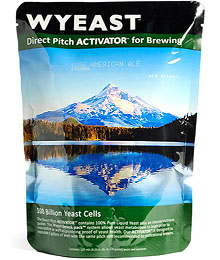 Continuing our exploration of homebrewing terminology, this week we will focus on some characteristics and terms you may hear having to do with beer yeast. A basic understanding of these words will help you produce the beer you want to drink.
Continuing our exploration of homebrewing terminology, this week we will focus on some characteristics and terms you may hear having to do with beer yeast. A basic understanding of these words will help you produce the beer you want to drink.
- Attenuation – Attenuation is a percentage that describes that amount of sugar consumed by yeast. If you want a beer that finishes dry, you should consider a highly attenuative beer yeast. Example: Wyeast 1028: London Ale has an attenuation of 73-77%.
- Flocculation – Flocculation describes the tendency of beer yeast to clump together and fall out of suspension. A well-flocculating beer yeast will be easier to clear. A yeast that doesn’t flocculate very well may cause haze or have an impact on flavor.
- Lipids – Lipids are a category of molecule that, among other things, include fats. Lipids are a natural component of malt and beer yeast need some lipids in order to reproduce. But any excessive lipids can negatively affect the head stability of your homebrew. Be careful when brewing with nuts…or bacon for that matter.
- Acetaldehyde – If you’ve ever had a beer that smelled like green apples you’ve probably picked up on acetaldehyde. It’s a natural by-product of fermentation, but excessive amounts smell like Granny Smith apples. Be extra careful with fermentation temperatures when brewing high gravity beers. Acetaldehyde can also indicate bacterial infection.
- Diacetyl – Another by-product of fermentation, diacetyl is a chemical that gives off a buttery aroma, just like movie theater popcorn. Brewers will sometimes utilize a “diacetyl rest” at the end of fermentation, a slight rise in temperature which encourages yeast to consume diacetyl. Low levels of diacetyl are considered acceptable in some styles of beer.
- DMS – DMS, or di-methyl sulfide, is yet another chemical compound produced by fermentation. It is also produced while heating wort. In large amounts, DMS smells like canned corn or cooked vegetables. To avoid DMS, seek a vigorous, rolling boil and leave the brew kettle uncovered. During fermentation, keep temperatures in check.
- Esters – Like phenols (see part 1), esters are an aromatic product of fermentation, usually described as fruity or spicy. Esters tend to be more common at higher fermentation temperatures. For some beer styles, esters are desired. Check the BJCP Guidelines for whatever style you’re brewing to find out if esters are appropriate. Esters can be manipulated by yeast selection and fermentation temperature.
- Autolysis – Autolysis is yeast death. It can cause off-flavors sometimes described as burned rubber. It isn’t very common, but if beer is left on the yeast in the fermentation vessel for too long and at too high a temperature, autolysis may occur.
Are there any other homebrewing terms you’d like to learn about? Share in the comments below!
————————————————————————————————————-
David Ackley is a beer writer, brewer, and self-described “craft beer crusader.” He holds a General Certificate in Brewing from the Institute of Brewing and Distilling and is founder and editor of the Local Beer Blog.
